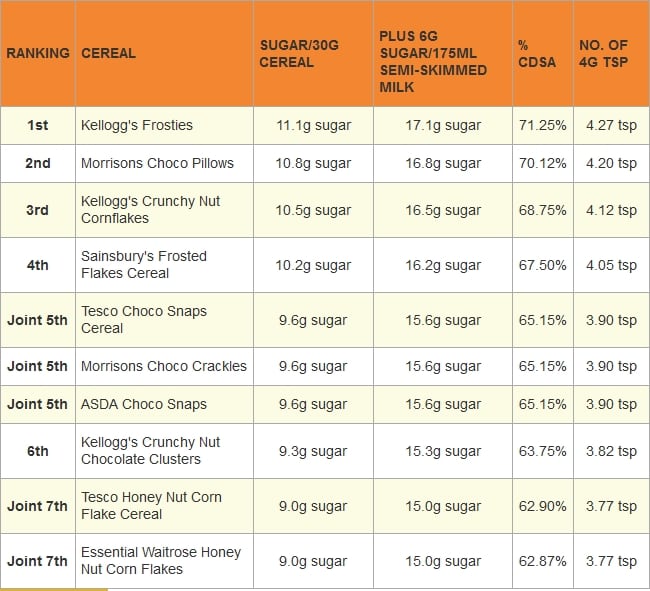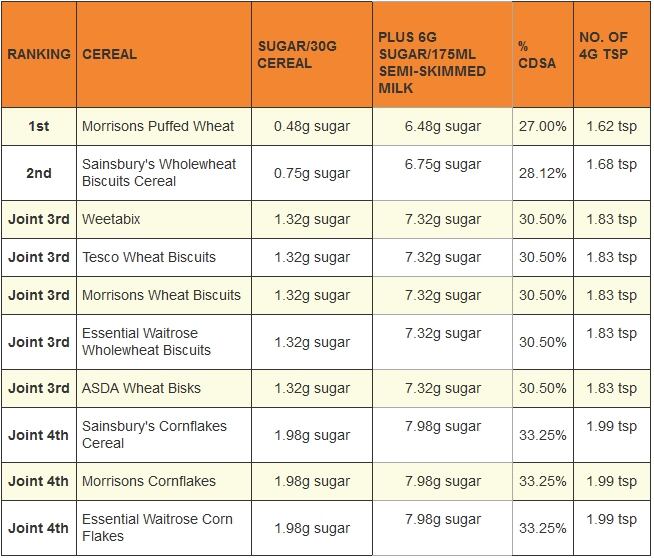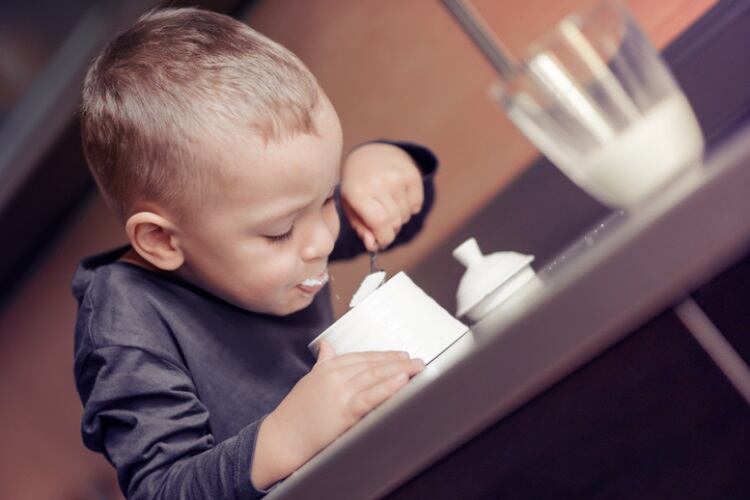The study, undertaken by UK kitchen accessories supplier Sinks-Taps to boost their profile within the F&B space, revealed that – even though some cereal manufacturers have reduced the sugar content in many of their brands – some could still be considered to contain a very high sugar content.
However, Kellogg told BakeryAndSnacks the figures from the study could be misleading as they include sugars from milk, which is not included in a child’s recommended daily sugar intake.
The study was conducted by marketing agency Screaming Frog in July with data garnered from the sugar content on the labels of 99 brands of cereals sold in the UK. This was measured against the NHS recommendation of a maximum of 24g of sugar per day for children aged between seven and 10.
Cereal is cereal is cereal?
“We looked at the amount of sugar in 100g [of cereal] and then normalized the amounts to 30g (the most common recommended serving size), and included 125ml of semi-skimmed milk,” said Richard Broadbent, MD of Sinks-Taps. He noted no additional sugar was added to the cereal and milk.
“From there, we could calculate how much sugar they contained.
“The biggest challenge was keeping to the recommended portion as it’s surprising how small a 30g bowl of cereal really is,” he added. “Realistically, I think this is a lot smaller than what the average child will consume each morning.”
The study found that more than 50% of the breakfast cereal brands examined contain 50% or more of the recommended children’s daily sugar allowance (CDSA) in one 30g bowl when served with 125ml of semi-skimmed milk (which itself contains 6g of sugar).
The biggest culprit of those studied was Kellogg’s Frosties, with 17.1g of sugar per 30g of cereal, which, when 125ml of semi-skimmed milk is added, accounts for 71.25% of CDSA. The study noted this is the equivalent of 4.26 teaspoons of sugar (or three fingers of KitKat or almost half a 330ml can of Coca Cola).
Another Kellogg brand coming into the Top 10 brands with the highest sugar levels in the study was Crunchy Nut: 10.5g of sugar per 30g of cereal plus 6g of sugar from the semi-skimmed milk makes it 68.75% of CDSA.
Sweet move
Earlier this year, the cereal giant slashed the sugar content in its Coco Pops by a massive 30% to 17g of sugar per 100g of cereal, ahead of the UK government’s 20% less sugar target by 2020.
However, according to the study, this still accounts for 46.25% of a child’s daily allowance when served with 125ml of semi-skimmed milk (equating to 27% of the NHS’s sugar recommendation).
“While there is definitely some progress, but considering it is still almost half of a child’s whole sugar allowance, it’s nowhere near a healthy treat, even if eaten occasionally,” said Broadbent.
“Educating consumers on the nutritional value of products is also paramount, so they can make more informed choices, empowering the customer and establishing more trust in the brand.”
Own brand cereals, while cheaper, are not necessarily better in terms of sugar.
The study found Morrisons Choco Pillows came in with the second highest sugar level of those studied, at 70.13% of CDSA in one 30g bowl with semi-skimmed milk (equivalent of 4.21 teaspoons of sugar or roughly ¾ of a Snickers bars).
Nestlé’s range of popular breakfast bowls, while well below Kellogg’s Frosties, still contained more than half of a CDSA per 30g of cereal when served with semi-skimmed milk.
Nestlé Cookie Crisp came in at 7.5g of sugar, or 56.25% of CDSA, while Cheerios was measured to contain 5.4g of sugar per 30g of cereal, totaling 47.5% of the CDSA (or two fingers of Kit Kat). Both bowls were calculated with the addition of 125ml of semi-skimmed milk.
On the other side of the scale, the study found the ‘healthiest’ (in terms of the lowest sugar content) cereals were wheat biscuit-based cereals, such as Weetabix, and Cornflake-like cereals – with the supermarket brands coming in with less sugar than traditional brands.
The star contender of the 99 ranked cereals is Morrisons Puffed Wheat, with just 0.48g of sugar per 30g of cereal, which when added to 125ml semi-skimmed milk, accounts for 27% of CDSA.
Steps taken towards the 2020 sugar reduction goal
A Kellogg’s spokesperson told BakeryandSnacks that the cereal giant takes its responsibility to public health seriously.
“That’s why we’ve worked really hard to halve sugar in Coco Pops over the past year. We also reduced sugar in Rice Krispies so one bowl now has less than a teaspoon of sugar – both without the use of artificial sweeteners.”
According to Kellogg’s, the study does not clarify what it is referring to as a child’s daily allowance of sugar.
“They haven’t distinguished between total and free sugars (milk is a natural sugar so not included in a child’s recommended free sugar daily intake). The figures in the tables appear to be free sugars (although we can’t see a reference) but the article [published on the Sink-Taps website] reads as though they are referring to total sugars,” a spokesperson told this site.
A Nestlé spokesperson told this site the company has a continuous focus on how it can make its products better for consumers, a key part being to improve the nutritional value.
“We have been reformulating for over a decade, reducing sugar and salt while increasing levels of whole grain. Compared with 2003 levels, Nestlé Cereals sold in 2017 contained 508 million fewer teaspoons of sugar and, since 2010, we have reduced average sugar content by 15%. We continue to make good progress towards our commitment to reduce the average sugar content by a further 10% by the end of 2018 - that’s the equivalent of around 225 million fewer teaspoons of sugar in our nation’s diet.
“When compared to those cereals featured in sinks-taps.com study, Shredded Wheat would provide the lowest contribution to a child’s daily sugar allowance, containing 0.3g of sugar per 40g serving, without milk,” he added.
“We have also made a number of other changes, including the introduction of clear portion guidance. This differentiates between adult and child portions as well as color-coded front of pack labelling that we believe will help consumers make more informed choices.”
According to Nestlé, its Shredded Wheat and Shredded Wheat Bitesize cereals contain just one ingredient – 100% British wholegrain wheat. When compared to those cereals featured in the study, Shredded Wheat would provide the lowest contribution to a child’s daily sugar allowance, containing 0.3g of sugar per 40g serving, without milk. In addition to this, Less than 5% Sugar Oat Cheerios contains 1.4g of sugar per 30g serving, without milk.
Sainsbury’s spokesperson told us the retailer is committed to clearly labeling its products with the nutritional information to help customers make informed choice.
“In 2016, we reduced sugar by an average of 13% across our cereals range - this was the equivalent of removing 452 tons of sugar from our customers’ baskets every year. Public Health England’s recent sugar reduction progress report shows that we achieved the highest level of sugar reduction within cereals out of all the major retailers at -12.1%.”
A Tesco spokesperson declined to comment on the study, but did add the company has cut a lot of sugar out of its cereals in recent years.
BakeryandSnacks had not receive comment back from Waitrose, ASDA or Morrisons before going to print.
CDSA – child’s daily sugar allowance
Study
You can find the full data here: https://www.sinks-taps.com/articles/2018/8/8/99-children-s-cereals-ranked-by-sugar-content.
Top 10 cereal brands with the highest sugar levels

Top 10 cereal brands with the lowest sugar levels



